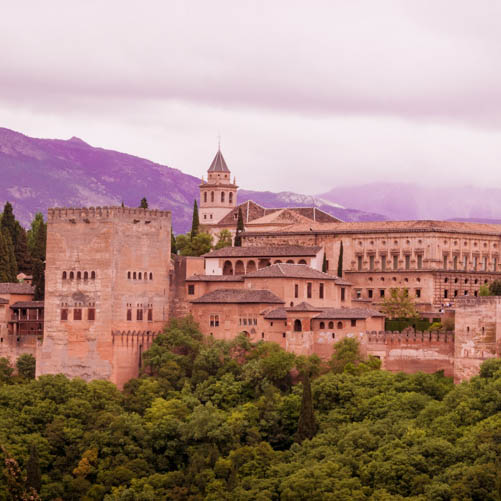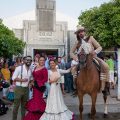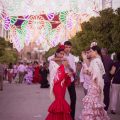Views like this make me dream
Mystery, magic, majesty. Those are the words that come to my mind when I see an epic photograph like this one. Dark, radiating city lights, a complete aerial view, as a God would see it. All the buildings and monuments can be seen outlined in the silhouette of the black night, illuminated by the street lights. On the edges of the skyline we can see the churches of Santa María de la Mota (Saint Mary of “La Mota”), Degollación de San Juan Bautista (Slaughter of Saint John the Baptist), San Agustín (Saint Augustine) and San Miguel Arcángel (Saint Michael Archangel).
We can also see in the contour both silos, the old and the new one (a silo is a tall building to store grains collected in agriculture), we can see in the foreground the neighborhood of Ciudad Jardín (Garden City), with its palm trees, the terrains of the fair, and the López de Arenas secondary education institute.
MARCHENA, a city with lots of history
The city’s coat of arms reads “COLONIA MARTIA ROMANORVM”, as this small city of 20,000 inhabitants 60 kilometers (37 miles) from the provincial capital, Seville, within the region of “La Campiña Sevillana”, had its origin in a Roman colony founded by a commander named MARTIA (although some historians argue that he may be named MARCIAL). After the Muslim invasion of the Iberian Peninsula and during the period of the AL-ANDALUS kingdom, the Muslims pronounced the name of the Roman colony as “MARSENAH”, more specifically “MARSENAH AL-ZAITUNA” which means “MARCHENA OF THE OLIVE TREES”, to differentiate it from the other villages also called Marchena (or “Marsenah”, in the period we are talking about). After the Christian reconquest, the name Marsenah began to be pronounced as Marchena, which is its current name (without the “of the olive trees”). As a curious fact, the inhabitants of Marchena (called “marcheneros”) pronounce the letter “ch” in a very particular way. Maybe it’s because of that change from the Arabic name “Marsenah” to “Marchena” (who knows?).
Despite having originated as a Roman colony, the truth is its existence is much earlier, because there are prehistoric remains of Tartessian-Phoenician-Carthaginian origin, where Carthaginian coins, a military and funeral complex, hydraulic and urban structures, and jewels of gold and silver were found. In a sacred place, funeral rituals were celebrated and animals were sacrificed. All this happened thousands of years ago in the same place where the current city of Marchena is located, nicknamed “The unknown beauty”.
Currently we can admire its beauty with monuments from the Muslim period, highlighting the Arco de la Rosa (“Arc of the Rose”, also called “Puerta de Sevilla” – “Entrance from Seville”), other remains of the wall that surrounded the city, including a few more towers, the remains of the Muslim citadel, located in the old part of the city, very close to the Tiro de Santa María, which was the entrance hall to the old Dukes Palace belonging to Duke Luis Ponce de León, which was located where the Muslim citadel used to be and where it sits now the Christian church of Santa María de la Mota.
We can also visit the museum of Lorenzo Coullaut Valera, a famous sculptor born in Marchena, to which many works belong, including the monument in honor of Béquer in the Maria Luisa Park in Seville. The museum is located in the part of the Muslim wall called “Puerta de Morón” (“Entrance from Morón”, “Morón de la Frontera” is another city near Marchena). There is also a valuable museum in the sacristy of the Church of the Slaughter of Saint John the Baptist, with 9 works of art by the famous painter Zurbarán.
We cannot forget the Christian churches that abound in the city: San Agustín, San Sebastián, San Miguel, Santa Clara, Degollación de San Juan Bautista, and Santa María de la Mota. There is also a new one under construction.
And of course we cannot forget our Holy Week (Easter Week), authentic works of art processioning through the streets with religious sculptures representing biblical scenes and accompanied by penitents, Roman centuries and bands of great talent and quality. A true magical, mystical and spiritual delight, full of charm that will enchant even non-believers, because it’s more than religion, it is an authentic performance of incomparable beauty and whose sensations you can only experience live.
And of course in our Marchena Fair we unleash all our passion full of flamenco, horses, gypsy costumes with their ruffles and their flower in their hair, wine and “rebujito” (a mixture of white wine of the variety “manzanilla” and soda lemon-lime drink like Seven-Up or Sprite) and lots of fun. You really have to live it to feel it.








